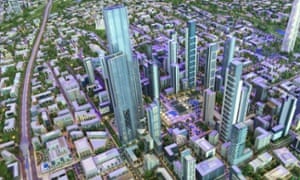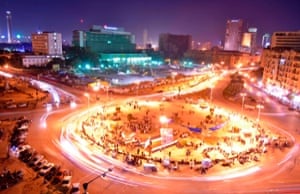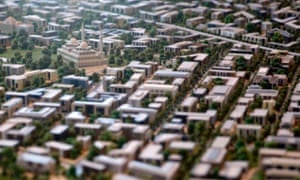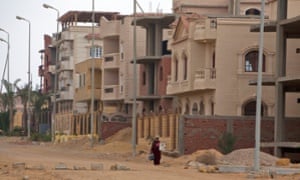
First renderings and models of new $45bn mega project released
A new New Cairo: Egypt plans £30bn purpose-built capital in desert

The currently nameless city of five million would be home to 660 hospitals, 1,250 mosques and churches, and a theme park four times the size of Disneyland – all to be completed within seven years.

a scale model of Egypt’s planned new capital
Egypt’s capital has moved two-dozen times in the country’s 5,000-year history, but its current seat of power has remained unchanged since AD 969. That was the year when Fatimid invaders began to build a grand enclosure to house their new mosques and palaces – a private city known to its residents as al-Qahera, and eventually to the world as Cairo.
But a millennium on, and nearly 20 million inhabitants later, Cairo’s time might finally be up – if Egyptian officials are to be believed.
The government has announced plans to pass Cairo’s baton to another foreign-helmed development. Just as al-Qahera once was, this new capital is to be built from scratch – in this case by the Emirati businessman behind the Burj Khalifa – on virgin sands to the east of its predecessor.

“Egypt has more wonders than any other country in the world, and provides more works that defy description,” said the bombastic housing minister, Mostafa Madbouly, as he unveiled the £30bn project in front of 30 visiting emirs, kings and presidents, and hundreds of would-be investors. “This is why it is necessary for us as Egyptians to enrich this picture – and to add to it something that our grandchildren will be able to say enhances Egypt’s characteristics.”

The scale of the plans certainly defy historical norms. If completed, the currently nameless city would span 700 sq km (a space almost as big as Singapore), house a park double the size of New York’s Central Park, and a theme park four times as big as Disneyland – all to be completed within five to seven years.
According to the brochure, there will be exactly 21 residential districts, 25 “dedicated districts”, 663 hospitals and clinics, 1,250 mosques and churches, and 1.1m homes housing at least five million residents.

Traffic in Tahrir Square. Cairo’s population is forecast to double over the next 40 years.
In terms of population, that would make it the biggest purpose-built capital in human history – nearly as large as Islamabad (population: an estimated 1.8 million), Brasilia (2.8 million), and Canberra (380,000) put together.
In certain quarters in Egypt, these astonishing numbers have been hailed by those who desperately hope a new capital can symbolise a process of national renewal under President Abdel Fatah al-Sisi, after several years of deep social division, political upheaval and economic crisis.

Writing in a state-owned newspaper, columnist Sayed el-Bably confidently said the city exemplified how the economic conference at which it was announced would allow Egypt to “convert dreams into facts and projects”. In a nod to failed attempts to build a new capital under Hosni Mubarak, Bably said that Egyptians can now “think, dream, and look forward to the completion of what we previously thought was impossible”.
But the problem for the likes of Bably and Madbouly is that there are also those who doubt this particular dream will ever reach reality.

“Based on historic and global track records, trying to build a new city from scratch is a massive gamble,” says Brent Toderian, Vancouver’s former chief planner, and a consultant for several cities outside of the Middle East. “The most concerning thing to me was the speed at which this is intended to be built – five to seven years. That’s incredibly fast. And if you build it that fast, it will be a ghost town, like most other development plays have been.”
Toderian cites less ambitious projects in China – places like Caofeidian, which hoped to attract a million residents but ended up with only a few thousand. Dubai is an obvious counter-example of success. But elsewhere in the UAE, the new “city” called Masdar (founded, incidentally, by the minister now driving Emirati investment in Egypt, Sultan al-Jaber) was supposed to house 50,000 people by now. Instead, it has just a few hundred.

A model of the planned new capital was displayed for investors during the Egypt Economic Development Conference in Sharm el-Sheikh
the money to build at least 100 sq km of the new capital, including a new parliament. “We are committed for the first phase,” he says. “We have already a very clear plan.”
But in Egypt, even the best urban plans have tended to go awry. Egypt has a history of building unfinished towns in the desert, but we don't this might be happens in "sisi active period" . the product of a decades-old belief that satellite developments will curb overcrowding in its main cities. In theory, the strategy is based in logic: around 96% of Egyptians live on just 4% of Egyptian land, and as the population mushrooms, relocating some of the former might solve the congestion in the latter.

But experience, time and again, has suggested otherwise. These 22 existing “new towns” – some of them more than 30 years old – still collectively hold little more than a million residents, and contain thousands of empty homes. Far from Cairo’s madding crowds, they are in theory an attractive prospect for many Egyptians. But in practice, most cannot afford to move there.
In the most notorious example, New Cairo, a recent suburb to the east of its namesake, was meant to attract several million residents. But after a decade and a half it still only holds a few hundred thousand – an irony lost on Egypt’s investment minister, Ashraf Salman, when he quipped that Cairo’s yet-to-be-named replacement would be “the new New Cairo”.

A new administrative capital called “The Capital Cairo” was announced by Minister of Housing Mostafa Madbouly at the Economic Summit .

The Capital Cairo is one of the largest-of-its-kind infrastructure development projects in the world, and will form a key part of the government’s economic reform programme.
The project will cost $45bn, and will take between five to seven years to complete, Madbouly added. He expected that the population of greater Cairo, currently estimated at about 18 million, will double within 40 years.

The suburb of New Cairo was meant to attract several million residents, but a decade on is only home to a few hundred thousand.
With a land area of approximately 700sqkm, The Capital Cairo marks one of the largest Foreign Direct Investments (FDIs) in Egypt’s infrastructure development. The entire project is 12 times the area of Manhattan, seven times larger than Paris, and four times that of Washington DC and is expected to house 7 million people on completion.

“The Capital Cairo must be a model 21st century city for the region… The city will cater to the needs of Egypt’s youth and future generations,” Madbouly said. “It will include neighbourhoods for all groups of Egyptian society and be a critical centre for new employment. It will be truly diverse, catering to all groups of Egyptian society, allowing Egypt to enter new era.”
The Egyptian parliament, government departments and ministries, as well as foreign embassies, would move to the new metropolis, Madbouly added.

The new city will be situated along the corridor between Cairo and the Red Sea, providing linkages to significant shipping routes. The city is bound to become a focal point of the Eastern Cairo region.
With over 10,000km of boulevards, avenues and streets, the city will be pedestrian-friendly. It will have vibrant recreational spaces to bring people together. It will be buzzing with life day and night.

No comments:
Post a Comment
Note: Only a member of this blog may post a comment.